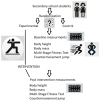Concurrent Effects of Plyometric Interval Training Implemented in Physical Education Lessons on Adolescent Power and Endurance: An Analysis of Responder Prevalence
- PMID: 39852610
- PMCID: PMC11768485
- DOI: 10.3390/sports13010015
Concurrent Effects of Plyometric Interval Training Implemented in Physical Education Lessons on Adolescent Power and Endurance: An Analysis of Responder Prevalence
Abstract
Schools provide an ideal setting for enhancing adolescents' health and fitness. Short-term intensive interventions are particularly relevant, but the effectiveness of plyometric exercises in jointly improving aerobic and anaerobic performance remains uncertain. This study aimed to evaluate the effects of plyometric-based training, in the form of interval workouts during physical education lessons, on power and endurance in adolescents. A total of 87 boys and 95 girls (aged 14-15 years) participated in an 8-week intervention, performing plyometric exercises twice weekly during physical education classes. The analyzed parameters were jump height (JH) measured by countermovement jump (CMJ) and distance covered during multistage fitness test (MFT). The results showed significant improvements among boys participating in the JH experiment and the distance covered in the MFT (p < 0.05); thus, the effect sizes were relatively small (ES < 0.3). Also, the prevalence of positive responders was more common for boys than girls; however, the difference was statistically insignificant (p = 0.09). These findings suggest that plyometric training has the potential for improving physical fitness, even in the context of developing opposing physical abilities, particularly in boys. However, the effects varied across individuals and were generally small, highlighting the need to optimize the intervention to achieve more pronounced results tailored to individual characteristics.
Keywords: aerobic; anaerobic; endurance; health; physical fitness; plyometric exercises; power; school-based setting; secondary school; youth.
Conflict of interest statement
The authors declare no conflicts of interest.
References
-
- Men J., Zou S., Ma J., Xiang C., Li S., Wang J. Effects of high-intensity interval training on physical morphology, cardiorespiratory fitness and metabolic risk factors of cardiovascular disease in children and adolescents: A systematic review and meta-analysis. PLoS ONE. 2023;18:e0271845. doi: 10.1371/journal.pone.0271845. - DOI - PMC - PubMed
LinkOut - more resources
Full Text Sources


